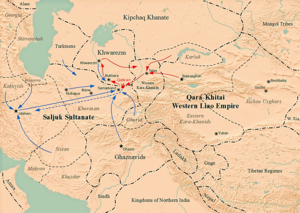Battle of Qatwan
| Battle of Qatwan | |||||||
|---|---|---|---|---|---|---|---|
 Configuration of the Battle of Qatwan. | |||||||
| |||||||
| Belligerents | |||||||
|
Qara Khitai(Western Liao) Karluks |
Great Seljuq Empire Kara-Khanids Kakuyids | ||||||
| Commanders and leaders | |||||||
| Yelü Dashi |
Ahmed Sanjar Garshasp II† Mahmud Qarakhan | ||||||
| Strength | |||||||
| 20,000[2]–300,000–700,000 (exaggerated Muslim figure)[3][a] | 100,000[4] | ||||||
| Casualties and losses | |||||||
| Unknown | 50,000[5] | ||||||
Location within West and Central Asia | |||||||
TheBattle of Qatwan(Chinese:Tạp đặc vạn chi chiến) was fought in September 1141 between theQara Khitai(Western Liao dynasty) and theSeljuk Empireand its vassal-state theKara-Khanid Khanate.The battle ended in a decisive defeat for the Seljuks, signaling the beginning of the end of the Great Seljuk Empire.
Background
[edit]TheKhitanswere people of theLiao dynastywho moved west from Northern China when theJin dynastyinvaded and destroyed the Liao dynasty in 1125. Liao remnants were led byYelü Dashiwho took the EasternKarakhanidcapital ofBalasagun.In 1137, they defeated the Western Karakhanids, avassalof the Seljuks, atKhujand,and the Karakhanid ruler Mahmud II appealed to his Seljuk overlord Ahmed Sanjar for protection.[6]
In 1141, Sanjar with his army arrived inSamarkand.The Kara-Khitans, who were invited by theKhwarazmians(then also a vassal of the Seljuks) to conquer the lands of the Seljuks, and also responding to an appeal to intervene by theKarlukswho were involved in a conflict with the Karakhanids and Seljuks, also arrived.[7]
Battle
[edit]Widely varying figures from different sources were given for the Kara-Khitan forces, ranging from 20,000[2]to 300,000,[4]and 700,000,[3]while the Seljuk forces numbered 100,000.[4]The Kara-Khitans were also said to have been given a reinforcement of 30,000–50,000 Karluk horsemen.[8]While many Muslim sources suggested that the Kara-Khitan forces greatly outnumbered the Seljuks, some contemporary Muslim authors also reported that the battle was fought between forces of equal size.[9]
The battle took place on the Qatwan steppe, north of Samarkand, on 9 September 1141.[10][11]The Kara-Khitans attacked the Seljuk forces simultaneously, encircled them, and forced the Seljuq center into awadicalled Dargham, about 12 km from Samarkand. Encircled from all directions, the Seljuq army was destroyed and Sanjar barely escaped. Figures of the dead ranged from 11,000 to 100,000.[12]Among those captured at the battle were Seljuq military commanders and Sanjar's wife.[12]
Aftermath
[edit]Yelü Dashispent ninety days in Samarkand, accepting the loyalty of Muslim nobles and appointing Mahmud's brother Ibrahim as the new ruler of Samarkand. However, Yelü did allow the Muslim Burhan family to continue to ruleBukhara.After this battle,Khwarazmbecame a vassal state of the Kara-Khitan. In 1142, Yelü sent Erbuz to Khwarazm to pillage the province, which forcedAtsizto agree to pay 30,000 dinars annual tribute.[12]
Historical accounts
[edit]Accounts of the battle are given in a number of sources, for example inSadr al-Din al-Husayni'sArabicchronicle of the Seljuks. He wrote that "there was no unanimity" among the emirs of Sanjar, therefore, soon after the start of the battle, Sanjar's troops began to retreat leaving him "with a small number of soldiers." Seeing that the enemy gained advantage in the battle and were close to Sultan's location, Abu'l Fadl advised Sanjar to put an ordinary soldier in his own place, and save himself, which Sanjar did. Abu'l Fadl, however, remained with the soldier who played the role of the Sultan until the end of the battle, and was soon captured. Many emirs perished in the battle; some of those who were captured were executed at once. Turkan-Khatun was released for ransom of 500 thousanddinars,Emir Kumach and his son – for 100 thousand dinars, and Abu'l-Fadl was freed without ransom whenYelü Dashilearned that the sons of the ruler ofSegestanhad seized their father's possessions. The Kara-Khitan ruler said: “Such a hero should not be executed!”. After the defeat, Sanjar intended to go toBalkh,and his path lay close to the enemy's location, “since it was impossible to go by other roads.” However, Yelü Dashi ordered not to intervene; Al-Husayni attributes the following words to the Kara-Khitan ruler: “To close the path for the one who retreats means to force him into a desperate battle. And one who does not value his life and does not think about the consequences, can win".[13]
Legend
[edit]Stories of this battle, told during theSecond Crusade,filtered back to theHoly Land,inspiring stories ofPrester John.[2]
Notes
[edit]- ^"..he met Yeh-lu Ta-shih, who led an army reported by the Iraqi historian, Ibn al-Athir, as numbering 300,000 horsemen..[..]..Nor did other Moslem historians make any attempt to minimize the scope of the disaster. Some exaggeration is obvious, to be sure, in the attribution to Yehlu Ta-shih of 300,000 men."[4]
References
[edit]- ^Biran 2005,p. 41.
- ^abcAsimov 1999,p. 238.
- ^abBiran 2001,p. 61.
- ^abcdNowell 1953,p. 442.
- ^Bosworth 1970,p. 90.
- ^Biran 2005,p. 42.
- ^Biran 2005,pp. 41–43.
- ^Biran 2005,pp. 43–44.
- ^Biran 2001,p. 62.
- ^Biran 2005,p. 43.
- ^Grousset 1970,p. 160.
- ^abcBiran 2005,p. 44.
- ^Abu Bakr ar-Ravendi. "Rest of hearts and a miracle of joy", Chapter: on Tughril-beg,Oriental literatureArchived2021-04-19 at theWayback Machine.
Sources
[edit]- Asimov, M. S. (1999).The Historical, Social and Economic setting.Motilal Banarsidass.
- Biran, Michal (2001)."Like a Mighty Wall: The armies of the Qara Khitai"(PDF).Jerusalem Studies in Arabic and Islam.25:44–91.
- Biran, Michal (2005).The Empire of the Qara Khitai in Eurasian History: Between China and the Islamic World.Cambridge University Press.
- Bosworth, Clifford(1970). "Dailamīs in Central Iran: The Kākūyids of Jibāl and Yazd".Iran.8:73–95.doi:10.2307/4299634.JSTOR4299634.
- Grousset, René (1970).The Empire of the Steppes: A History of Central Asia.Rutgers University Press. p. 160.ISBN978-0-8135-1304-1.Archivedfrom the original on 9 September 2023.Retrieved7 September2020.
- Nowell, Charles E. (1953). "The Historical Prester John".Speculum.28, No. 3 (Jul).

